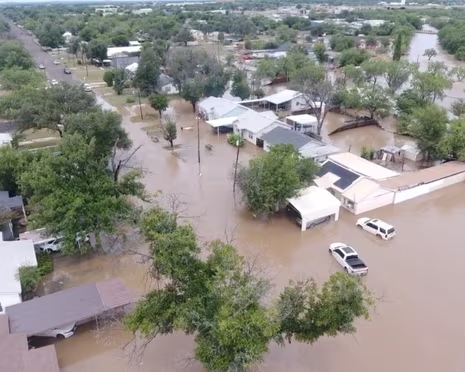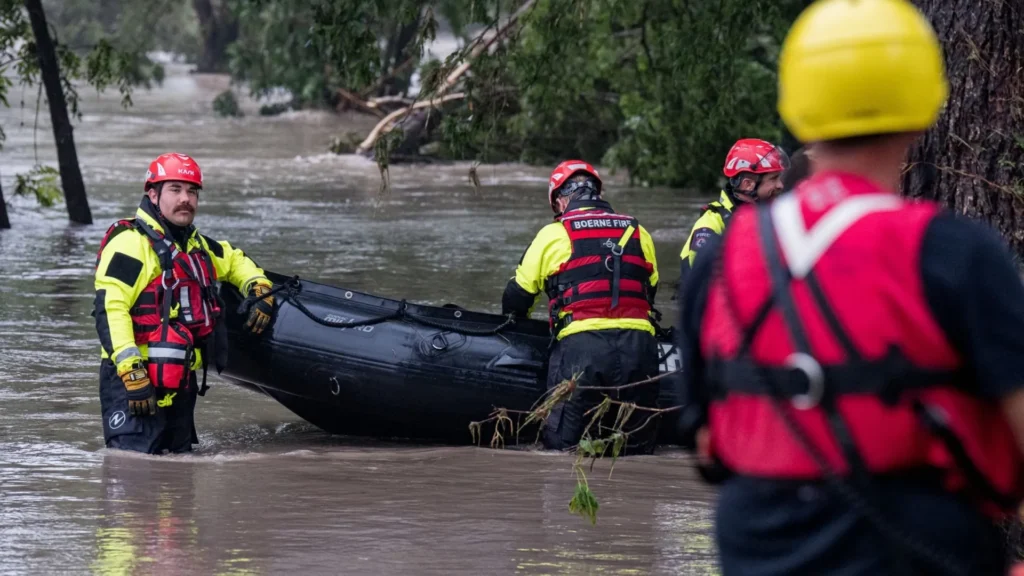Texas flooding flash flood:
- Catastrophic Event: Flash floods struck central Texas on July 4, 2025, causing significant loss of life and damage, particularly in Kerr County.
- Impact: Reports suggest at least 43 people, including 15 children, have died, with dozens still missing, including campers from Camp Mystic. Infrastructure damage appears extensive.
- Response: Over 850 people have reportedly been rescued, and a federal disaster declaration has been requested to aid recovery efforts.
- Uncertainty: The exact death toll varies across reports (43–52), and concerns have been raised about the adequacy of weather forecasting due to the unexpected intensity of the rainfall.

Overview
On July 4, 2025, central Texas, particularly Kerr County, was devastated by flash floods triggered by extreme rainfall. The Guadalupe River rose rapidly, causing widespread destruction, loss of life, and ongoing rescue efforts. The disaster has left communities reeling, with significant damage to infrastructure and local camps, prompting urgent calls for improved flood preparedness.
Causes and Contributing Factors
The floods were likely caused by an extraordinary 6.5 inches of rain falling in just three hours in Hunt, Texas, an event described as a 1-in-100-years occurrence. Some areas reported up to 20.33 inches of rainfall, partially attributed to the remnants of Tropical Storm Barry. The National Weather Service’s “moderate” flood watch reportedly failed to predict the severity, raising concerns about forecasting accuracy. Discussions on social media suggest that budget cuts to the National Weather Service may have impacted warning systems, though this remains a point of debate requiring further investigation.
Community and Infrastructure Impact
The floods severely impacted Camp Mystic, a nearly century-old Christian girls’ camp in Kerr County hosting 700 girls at the time of the disaster. Reports indicate 23–25 campers remain missing, and the camp’s facilities have been heavily damaged. Nearby, Heart O’ the Hills camp suffered a tragic loss, with co-owner Jane Ragsdale losing her life, though no campers were present as the flooding occurred between sessions. Personal accounts, such as that of Maria and Felipe Tapia, who swam out of their flooded home near the Guadalupe River, highlight the severity of the disaster. Infrastructure damage includes uprooted trees, blocked roads, destroyed bridges, and approximately 10 cars swept away by the river. Affected counties include Kerr, Travis, Kendall, Bandera, Comal, Concho, Gillespie, Kimball, Llano, Mason, McCullough, Menard, Reeves, San Saba, and Tom Green.
| Detail | Information |
|---|---|
| Location | Central Texas, primarily Kerr County, also affecting Travis and Kendall Counties |
| Rainfall | Up to 15 inches; Hunt received 6.5 inches in 3 hours (1-in-100-years event) |
| River Rise | Guadalupe River rose to 29 feet, with a 20-foot rise in 90 minutes at Hunt |
| Infrastructure Damage | Uprooted trees, blocked roads, damaged bridges, ~10 cars swept away |
| Affected Counties | Bandera, Comal, Concho, Gillespie, Kendall, Kerr, Kimball, Llano, Mason, McCullough, Menard, Reeves, San Saba, Tom Green |
Rescue and Recovery Efforts
Rescue operations have reportedly saved over 850 people, with 237 evacuated, many by helicopter. Agencies involved include the Houston Fire Department, Texas National Guard, US Coast Guard, FEMA, and Texas A&M Task Force One, utilizing 14 helicopters, 12 drones, and over 500 personnel, including 107 game wardens. The search for missing individuals, including the 23–25 campers from Camp Mystic and 13 others in Travis County, continues with urgency. Texas Governor Greg Abbott has issued a disaster declaration for multiple counties, and President Donald Trump has pledged federal aid, with Homeland Security Secretary Kristi Noem coordinating support. A reunification center has been established at Ingram Elementary, and shelters are available for those displaced.

| Response Detail | Information |
|---|---|
| Rescues | Over 850 people saved, 237 rescued/evacuated, many by helicopter |
| Missing Persons | 23–25 Camp Mystic campers, 13 in Travis County, dozens overall |
| Federal Support | Disaster declaration requested; federal aid pledged by President Trump |
| Agencies Involved | Houston Fire Department, Texas National Guard, US Coast Guard, FEMA |
Looking Ahead: Recovery, Preparedness, and Self-Protection
As central Texas braces for potential further rainfall, with the National Weather Service indicating that six million people remain under flood watches until Sunday afternoon or evening, July 6, 2025, the focus remains on finding missing individuals and rebuilding. This tragedy underscores the critical need for improved flood preparedness and forecasting to mitigate future risks. Residents are urged to take proactive steps to protect themselves and their families from future flooding events.
Flood Safety and Self-Protection Tips:
Flash floods are unpredictable and can be deadly, but taking the right precautions can save lives. Here are essential steps to protect yourself and your loved ones:
- Before a Flood:
- Develop a household emergency plan, including pets, outlining evacuation routes and communication strategies.
- Assemble an emergency kit with non-perishable food, water, medications, and important documents in a waterproof container.
- Learn your area’s flood risk by checking the FEMA Flood Map Service Center.
- Consider flood insurance through the National Flood Insurance Program if you live in a flood-prone area.
- Protect your property by moving valuables to higher levels, clearing drains and gutters, and installing check valves or a sump pump with a battery.
- During a Flood:
- Evacuate immediately if authorities issue an order, following designated routes and avoiding barricades.
- Never drive through flooded areas; remember the adage, “Turn around, don’t drown,” as just one foot of water can sweep away a vehicle.
- If you must walk, avoid moving water; six inches of moving water can knock you off your feet. Use a stick to check ground stability.
- Stay informed by monitoring NOAA Weather Radio or local news for flood watches and warnings. A watch indicates possible flooding, while a warning means flooding is imminent or occurring.
- Avoid contact with floodwater, which may be contaminated or electrically charged from downed power lines.
- After a Flood:
- Use extreme caution when returning to buildings, as hidden structural damage, particularly in foundations, may pose risks.
- Avoid areas where floodwaters have receded, as roads may be weakened and could collapse under a vehicle’s weight.
- Stay out of buildings surrounded by floodwaters and watch for hazards like debris, animals, or broken glass.
- Follow public health guidelines for cleanup to avoid health risks from contaminated water or mold.
By adopting these measures, residents can significantly reduce their risk during flash floods, ensuring greater safety for themselves and their communities.
TO Get more Information visit:http://fintechzoom-insights.com
Conclusions
The Texas flash floods of July 2025 have left a profound impact, with significant loss of life and widespread destruction. The varying reports of the death toll and questions about forecasting accuracy highlight the complexity of responding to such disasters. As recovery efforts continue, this tragedy emphasizes the need for enhanced weather forecasting, robust disaster preparedness, and community resilience. By learning from this event and implementing proactive safety measures, Texas can better protect its residents from future natural disasters.
FAQs
- What caused the flash floods in Texas?
- The floods were likely caused by up to 15 inches of rain in a short period, partially due to the remnants of Tropical Storm Barry, leading to a rapid rise in the Guadalupe River.
- How many people have died in the floods?
- Reports suggest at least 43 people, including 15 children, have died, though some sources indicate up to 52, pending further confirmation.
- How many people are still missing?
- Dozens remain missing, including 23–25 campers from Camp Mystic and 13 others in Travis County.
- What is being done to find the missing persons?
- Search and rescue operations involve multiple agencies using helicopters, drones, and ground teams with infrared technology.
- Is there a risk of further flooding?
- Additional rainfall is possible, with flood watches in place until Sunday afternoon or evening, July 6, 2025. Residents should stay vigilant and follow evacuation orders.
- How can I help the affected communities?
- Consider donating to reputable disaster relief organizations like the American Red Cross or volunteering with local relief efforts. Check local resources for shelter and support opportunities.
Citations:
- Reuters: Death toll from Texas floods reaches at least 43; dozens still missing
- CNN: Texas flooding leaves at least 24 dead, 20 Camp Mystic campers unaccounted for
- Wikipedia: July 2025 Central Texas floods
- The Guardian: ‘Catastrophic’ flood in Texas kills at least 24, including children
- NPR: At least 43 dead in catastrophic Texas flooding
- Ready.gov: Floods
- American Red Cross: Flood Safety

